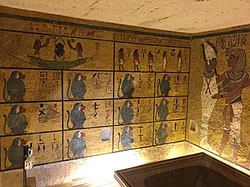| KV62 | |
|---|---|
| Burial site of Tutankhamun | |
 The wall decorations in KV62's burial chamber are modest in comparison with other royal tombs found in the Valley of the Kings. | |
| Coordinates | 25°44′25.4″N 32°36′05.1″E / 25.740389°N 32.601417°E |
| Location | East Valley of the Kings |
| Discovered | 4 November 1922 |
| Excavated by | Howard Carter |
| Decoration | |
| Layout | Bent to the right |
← Previous KV61 Next → KV63 | |
The tomb of Tutankhamun, also known by its tomb number, KV62, is the burial place of Tutankhamun (reigned c. 1332–1323 BC), a pharaoh of the Eighteenth Dynasty of ancient Egypt, in the Valley of the Kings. The tomb consists of four chambers and an entrance staircase and corridor. It is smaller and less extensively decorated than other Egyptian royal tombs of its time, and it probably originated as a tomb for a non-royal individual that was adapted for Tutankhamun's use after his premature death. Like other pharaohs, Tutankhamun was buried with a wide variety of funerary objects and personal possessions, such as coffins, furniture, clothing and jewelry, though in the unusually limited space these goods had to be densely packed. Robbers entered the tomb twice in the years immediately following the burial, but Tutankhamun's mummy and most of the burial goods remained intact. The tomb's low position, dug into the floor of the valley, allowed its entrance to be hidden by debris deposited by flooding and tomb construction. Thus, unlike other tombs in the valley, it was not stripped of its valuables during the Third Intermediate Period (c. 1070–664 BC).
Tutankhamun's tomb was discovered in 1922 by excavators led by Howard Carter. As a result of the quantity and spectacular appearance of the burial goods, the tomb attracted a media frenzy and became the most famous find in the history of Egyptology. The discovery produced only limited evidence about the history of Tutankhamun's reign and the Amarna Period that preceded it, but it provided insight into the material culture of wealthy ancient Egyptians as well as patterns of ancient tomb robbery. Tutankhamun became one of the best-known pharaohs, and some artefacts from his tomb, such as his golden funerary mask, are among the best-known artworks from ancient Egypt.
Most of the tomb's goods were sent to the Egyptian Museum in Cairo and are now in the Grand Egyptian Museum in Giza, although Tutankhamun's mummy and sarcophagus are still on display in the tomb. Flooding and heavy tourist traffic have inflicted damage on the tomb since its discovery, and a replica of the burial chamber has been constructed nearby to reduce tourist pressure on the original tomb.
